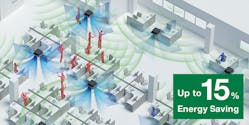Many remember how ductless first became popular in the U.S. in the early 2000s, as a solution for single-room applications. Now, much more is possible, thanks to multi-zone systems.
“The fastest growth in the ductless segment has been in multi-zone systems, which combine one outdoor unit with multiple indoor units. This is helping ductless become more accepted as an alternative,” Dziwoki said.
The popularity of ductless products has even nudged manufacturers of traditional ducted systems to design and market a branded ductless product, or to become aligned with an established ductless manufacturer. Dziwoki finds that to be an exciting development, one that, “Helps us to see what the industry is capable of.”
Dziwoki: “A few short years ago, we were wondering what contractors would do next for more business. It seems that ductless is that category, for both service and contractor profitability.”
With increased popularity comes the need for constant innovation, and Dziwoki believes Panasonic meets two important needs — energy savings and convenience — with ECONAVI sensor technology. Now available in Panasonic’s residential and commercial VRF products, ECONAVI Intelligent Sensors detect any unconscious waste of energy in a space. These sensors monitor human location, movements, and absence from the area. It then automatically adjusts cooling power to save energy efficiently, with uninterrupted comfort and convenience.
The Intelligent Sensors provide thorough cooling during high levels of activity and reduced cooling when fewer people are in a room. At night, an “Automatic Thermo Off” will turn the system off, depending on comfort conditions at the end of the day.
Panasonic tests have found that ECONAVI results in a power savings of up to 15% in commercial applications, and up to 38% in cooling mode in a residence.
But there’s more to be done as far as communications, because ductless products are still very new to the majority of residential contractors.
“It’s been primarily a replacement business, unless you’re working in new home construction,” Dziwoki explained. “Ductless is not their ‘bread and butter,’ work, so we as a manufacturer are trying to educate contractors on the many applications for ductless, and the problems it can solve. It’s not just a ‘niche’ product. And, they can also be very profitable installations, because of the reduced labor involved in a ductless installation compared to a more elaborate, ducted home system,” he said.
“The profit-per-man-hour in ductless is much higher than a ducted system, due to the labor savings. Do contractors want to make $1200 in four hours, or in 16 hours?” said Eric Griffin.
“When we speak with contractors, we try to help them see, if they could put 20 percent of the business into ductless, net profit will increase by X percent, just because of the better profit-per-man-hour. It makes a dramatic impact on their bottom line. You not only differentiate yourself from your competition by offering different ways to handle applications that make the customer more comfortable — you’re also improving profit for your company,” Griffin said.












